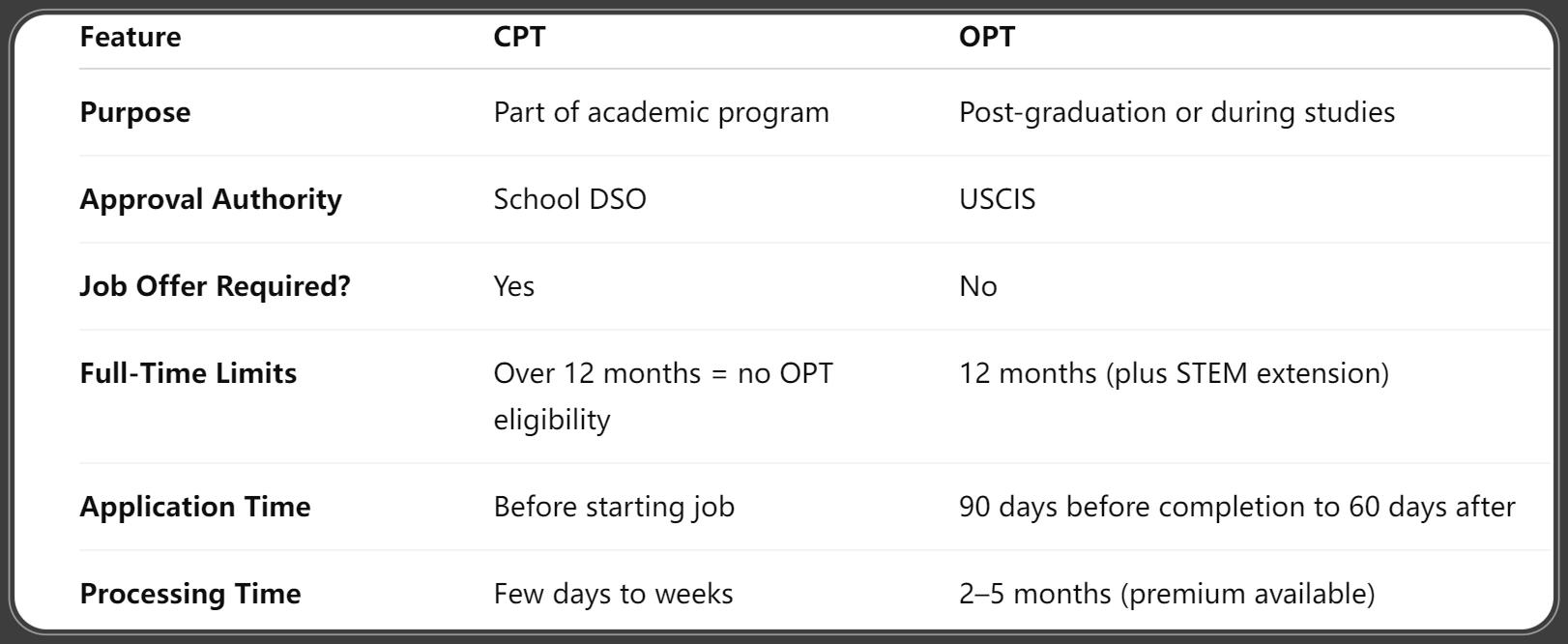CPT vs OPT 2025: Key Differences Every International Student Must Know
Published on August 12, 2025

Michael Rivera, Esq.
Senior Immigration Attorney
Michael Rivera, Esq., is a licensed immigration attorney with 12+ years of experience across family, employment, and student visas, representing clients from more than 30 countries.
Introduction: Why CPT and OPT Matter in 2025
For thousands of international students in the U.S., CPT (Curricular Practical Training) and OPT (Optional Practical Training) are the primary pathways to gain professional work experience while maintaining legal F1 visa status.
In 2025, updated immigration policies, stricter SEVIS monitoring, and new digital application systems have made it more important than ever to understand the difference between the two.
The Role of Work Authorization in F1 Visa Status
CPT and OPT allow students to bridge the gap between academic learning and real-world employment, ensuring they can apply classroom knowledge to their chosen career paths.
How Changes in 2025 Impact Students
- Digital I-20 endorsements for faster processing.
- Stricter limits on full-time CPT usage to avoid OPT ineligibility.
- New premium processing for certain OPT cases.
What is CPT?
Definition and Purpose
Curricular Practical Training (CPT) is work authorization for F1 students that is part of their academic program. This could include internships, cooperative education, or practicum experiences.
Types of CPT
- Part-Time CPT: Up to 20 hours/week while school is in session.
- Full-Time CPT: More than 20 hours/week, often during summer or official breaks.
Eligibility Requirements in 2025
- Must have completed one academic year in a SEVP-certified school.
- Employment must be directly related to your major.
- Job offer is required before CPT approval.
Duration Limits
There’s no total limit for CPT, but 12 months or more of full-time CPT makes you ineligible for OPT.
What is OPT?
Definition and Purpose
Optional Practical Training (OPT) allows F1 students to work up to 12 months in a job directly related to their major, either before or after graduation.
Types of OPT
- Pre-Completion OPT: Part-time work during school or full-time during breaks.
- Post-Completion OPT: Full-time work after graduation.
Eligibility Requirements in 2025
- Must have completed one academic year at a SEVP-certified school.
- No job offer is required at the time of application.
Duration Limits
- Standard OPT: 12 months.
- STEM OPT Extension: Additional 24 months for STEM degree holders.
Key Differences Between CPT and OPT

Application Process for CPT in 2025
Step 1: Meet with Your DSO
Discuss your job offer, ensure it meets CPT requirements, and get academic approval.
Step 2: Secure a Job Offer
Written confirmation from the employer is required.
Step 3: Get CPT Authorization on I-20
Your DSO will update SEVIS and issue a new I-20 with CPT details.
Application Process for OPT in 2025
Step 1: Request OPT Recommendation from DSO
They’ll update SEVIS and issue a new I-20 with your OPT request.
Step 2: File Form I-765 with USCIS
Submit your OPT application with the required fee and documents.
Step 3: Receive EAD Card
You can begin working only after receiving your Employment Authorization Document.
CPT vs OPT: Which One Should You Choose?
Best Choice for Current Students
CPT is ideal if you need work experience as part of your curriculum.
Best Choice for Graduating Students
OPT is better suited for gaining full-time post-graduation work experience.
Combining CPT and OPT Strategically
Use part-time CPT during studies and full OPT after graduation to maximize work time.
Common Mistakes in Choosing Between CPT and OPT
- Using too much full-time CPT and losing OPT eligibility.
- Applying for OPT too late.
- Violating employment rules by working without proper authorization.
Recent 2025 Policy Updates Affecting CPT and OPT
Digital Application Systems
More schools now process CPT and OPT I-20 endorsements electronically.
Increased SEVIS Monitoring
Failure to report employment changes promptly can lead to status violations.
Frequently Asked Questions on CPT vs OPT 2025
1. Can I do CPT and OPT?
Yes, but more than 12 months of full-time CPT makes you ineligible for OPT.
2. Can I work on CPT without a job offer?
No, a job offer is required before CPT approval.
3. Can I apply for OPT without a job offer?
Yes, OPT does not require an offer at the time of application.
4. How long does OPT take to process?
Regular processing takes 2–5 months; premium processing takes about 30 days.
5. Does CPT count toward the 12-month OPT limit?
Only if you do more than 12 months of full-time CPT.
Conclusion: Making the Right Work Authorization Choice
Understanding CPT vs OPT in 2025 can make or break your career planning as an international student. CPT is great for academic-related work during your program, while OPT offers post-graduation employment opportunities. Choosing the right one at the right time can maximize your U.S. work experience and future immigration prospects.
You Might Also Like
STEM OPT Extension 2025: Complete Guide for International Students
Aug 12, 2025F1 OPT Application 2025: Complete Step-by-Step Guide for International Students
Aug 12, 2025Student Visa Financial Proof 2025: Complete Guide for International Students
Aug 12, 2025Student Visa Denial Reasons 2025: Avoid These Common Mistakes
Aug 12, 2025Student Visa Interview Appointment 2025: Complete Step-by-Step Guide
Aug 11, 2025
